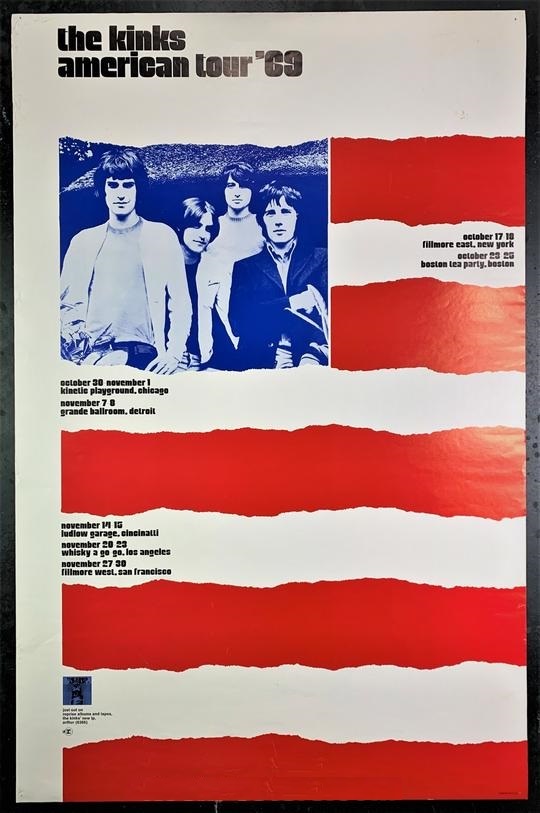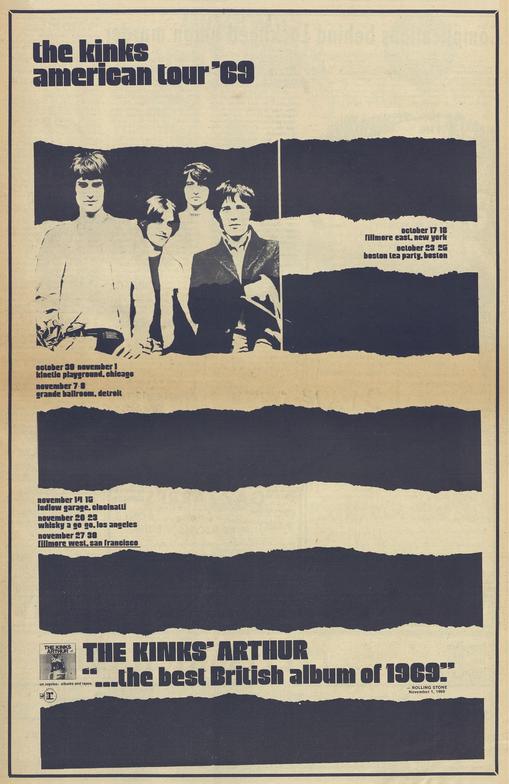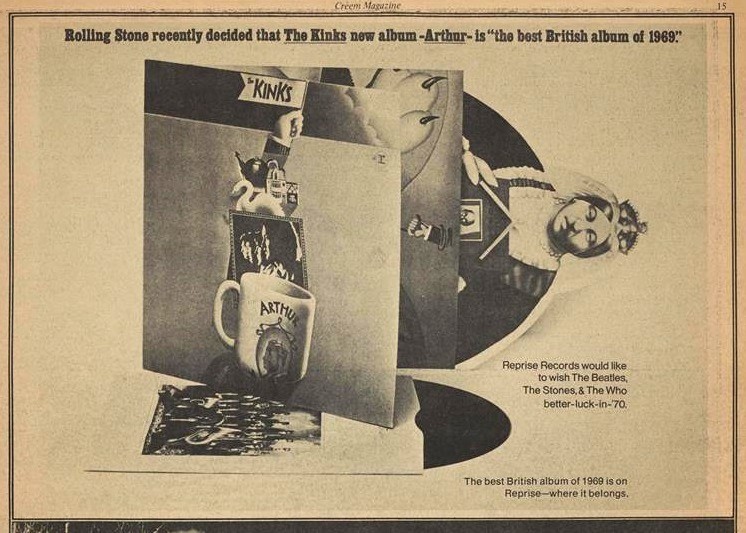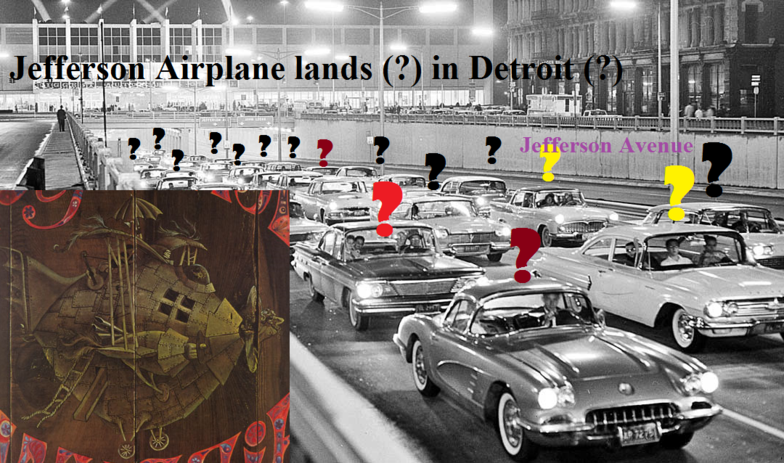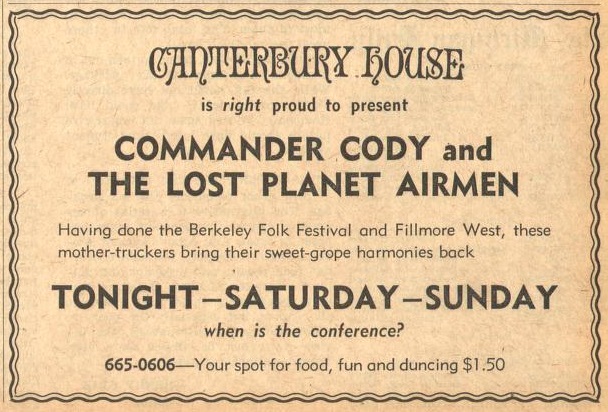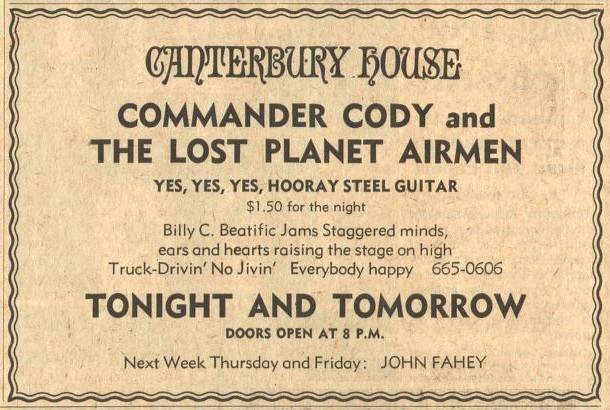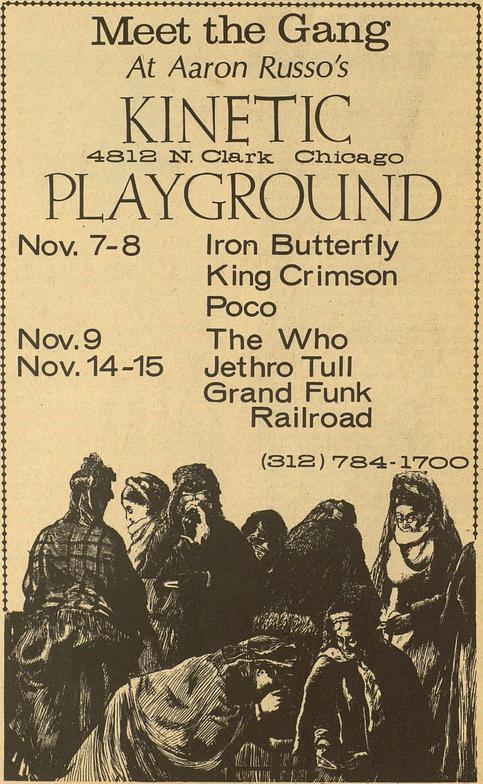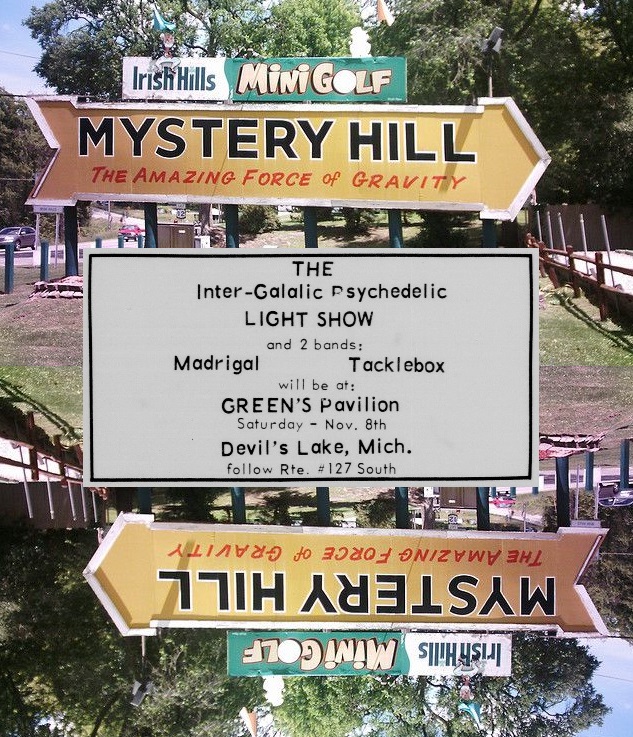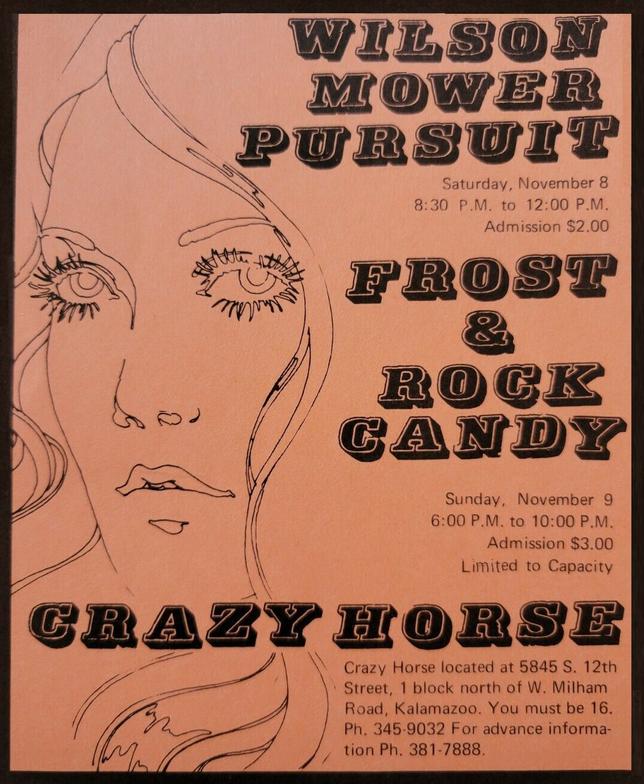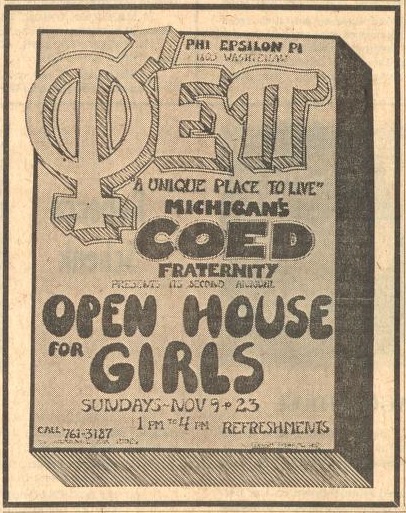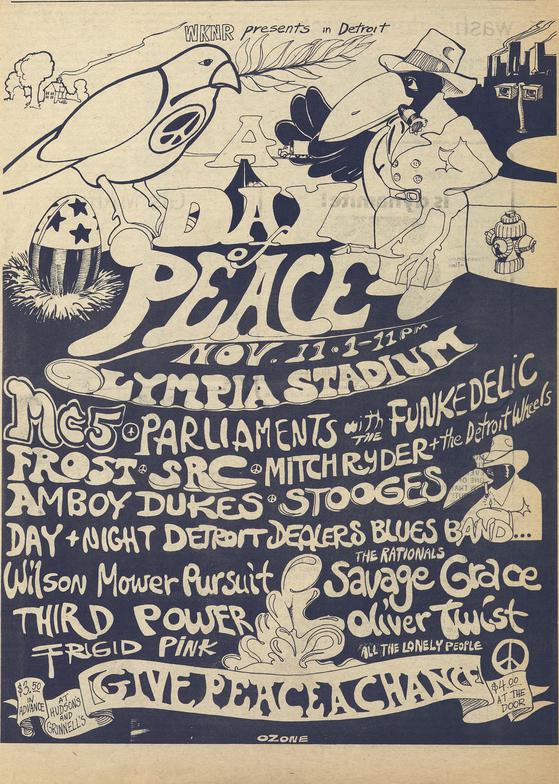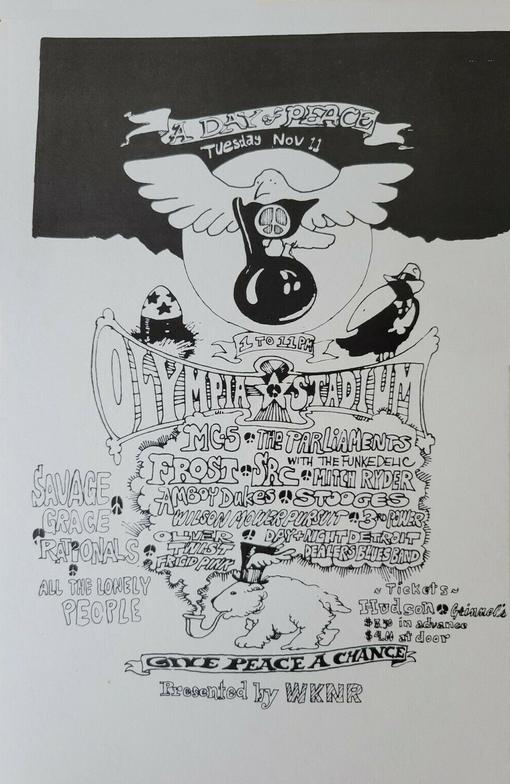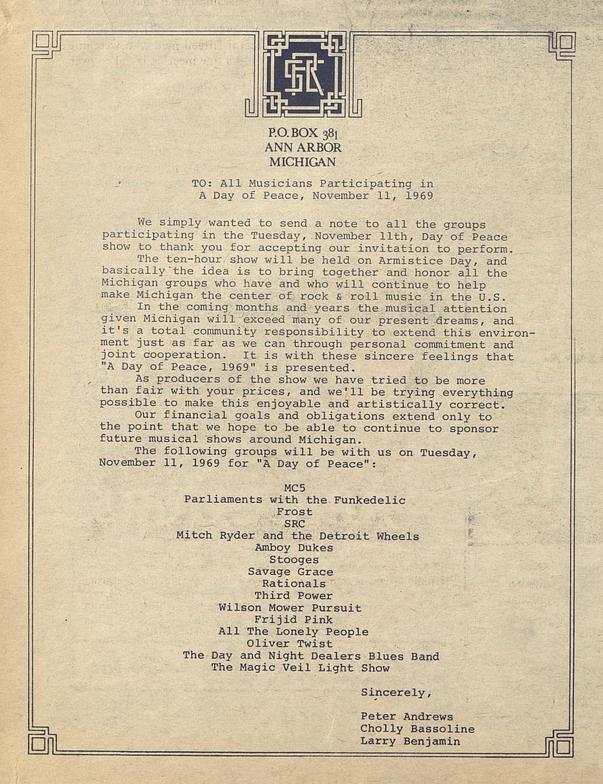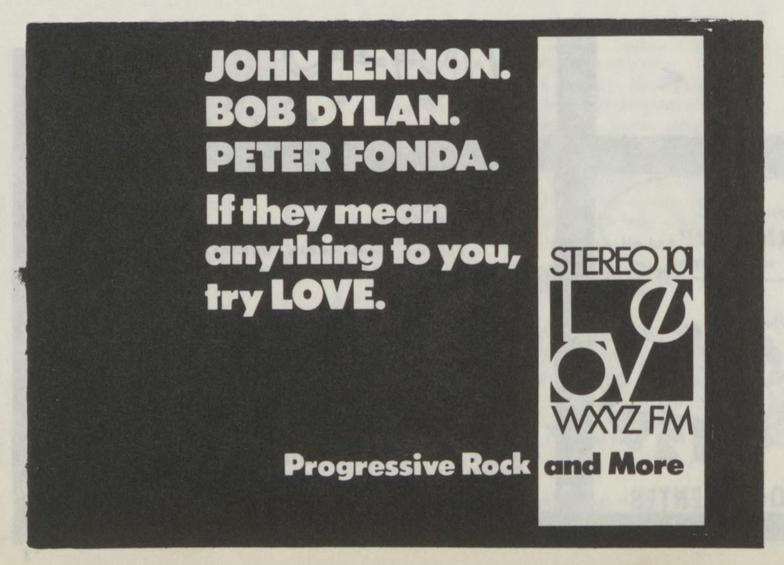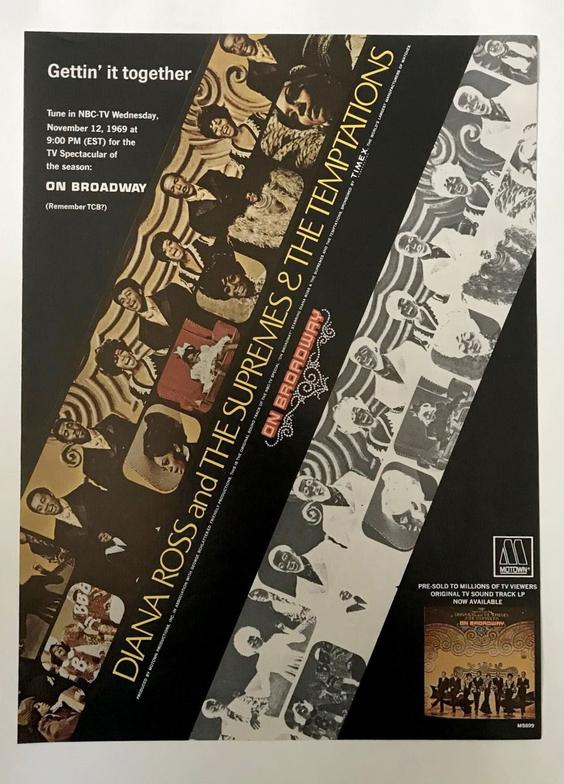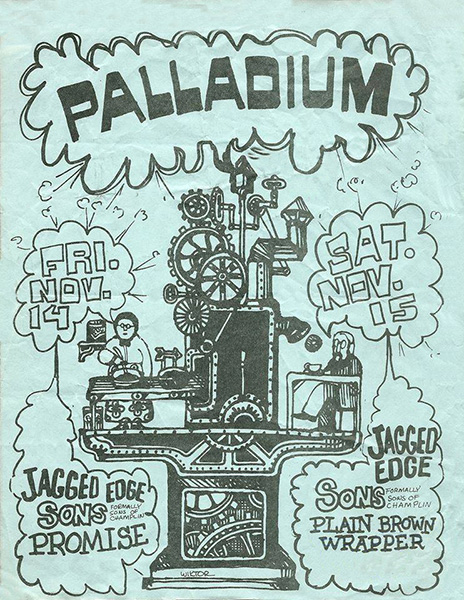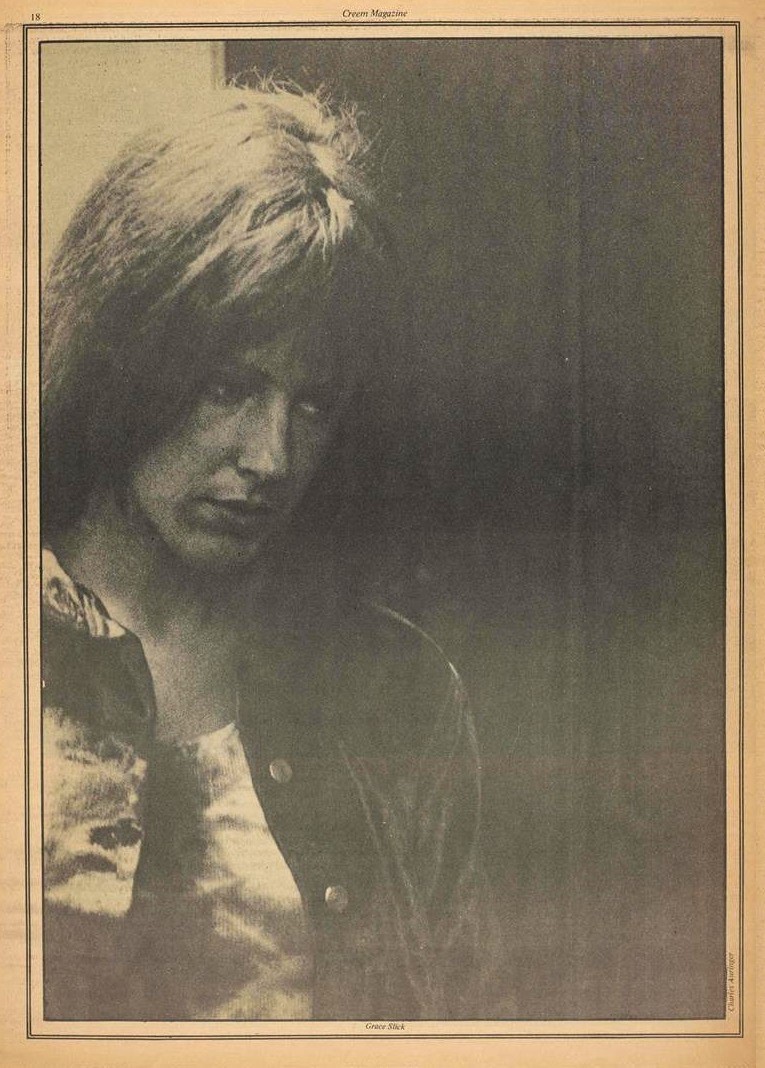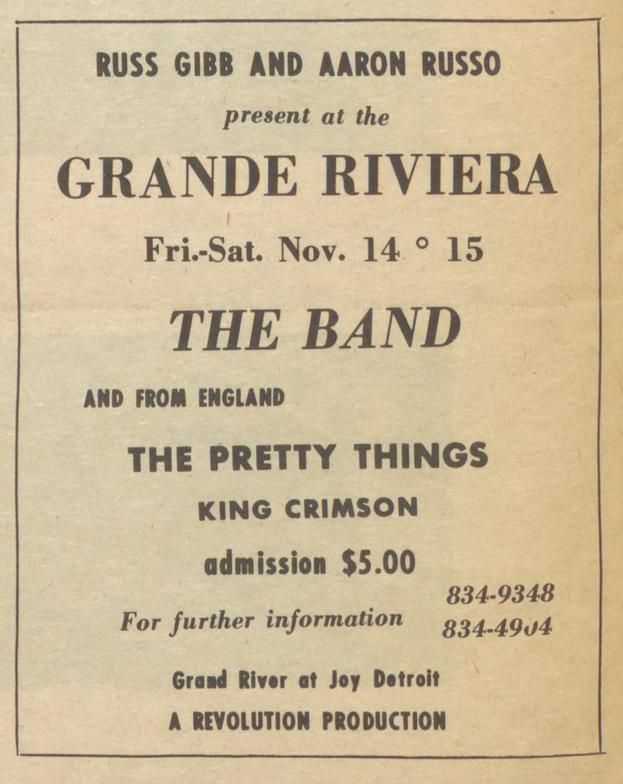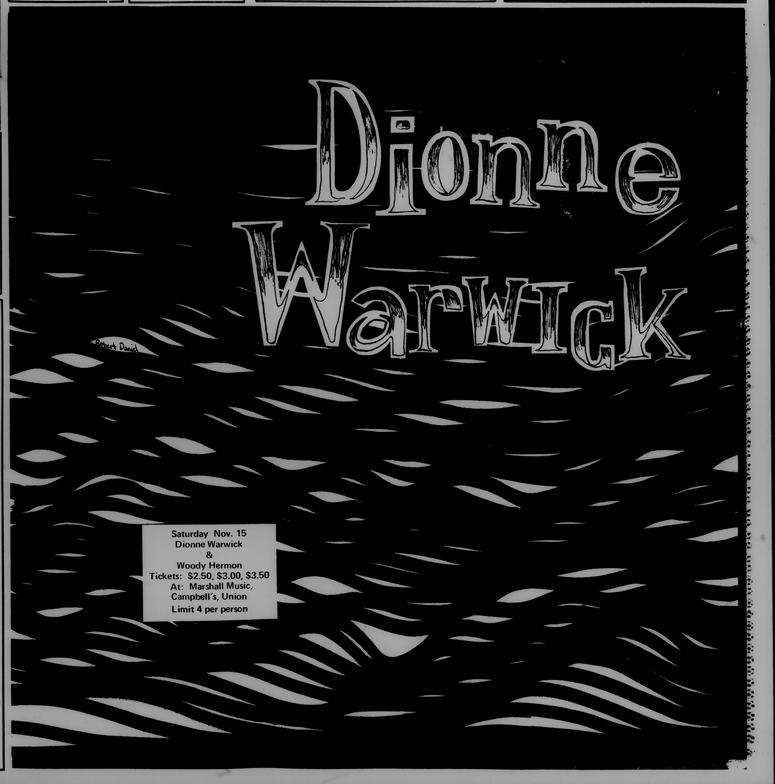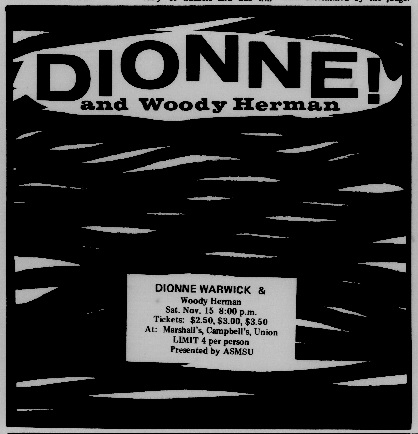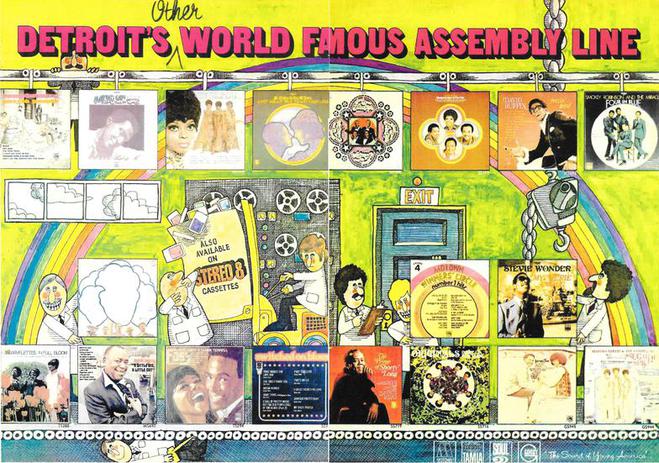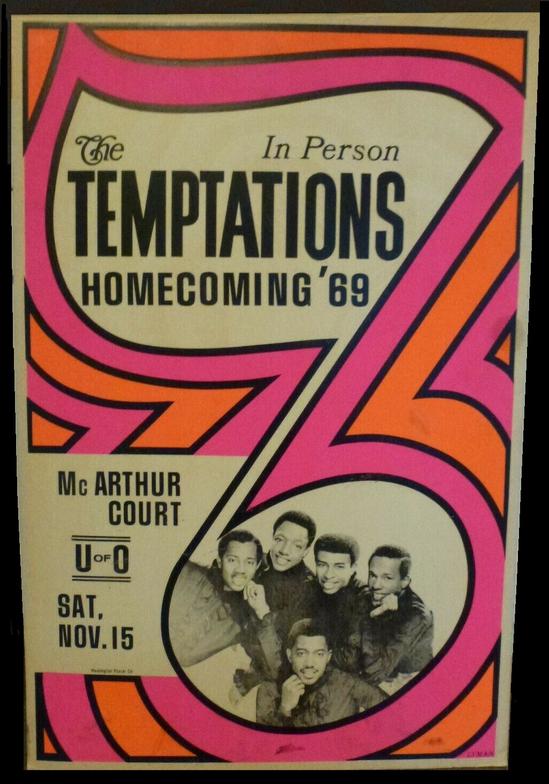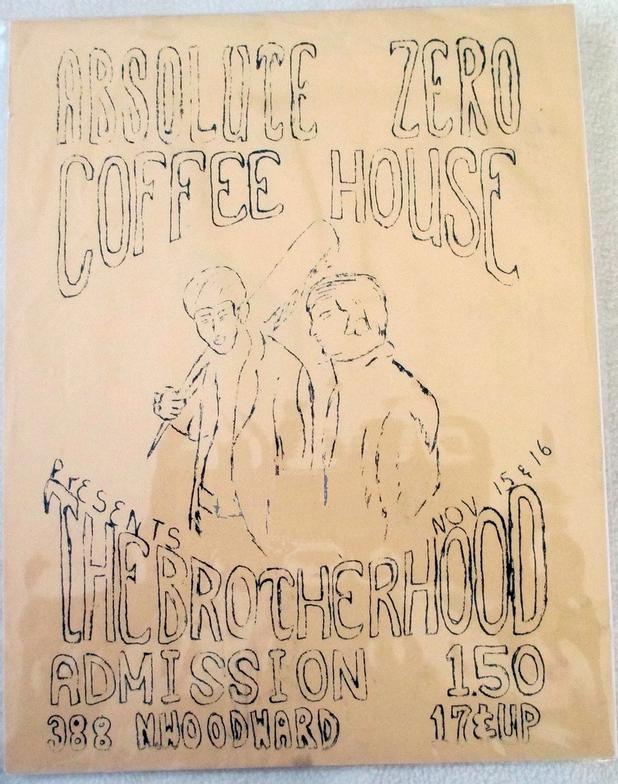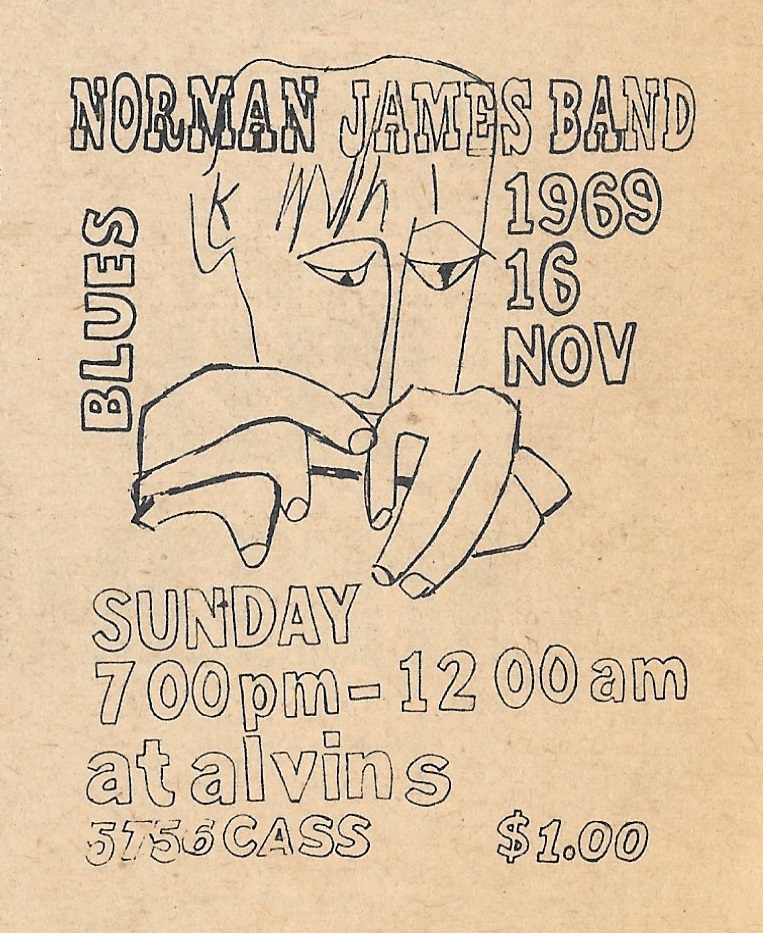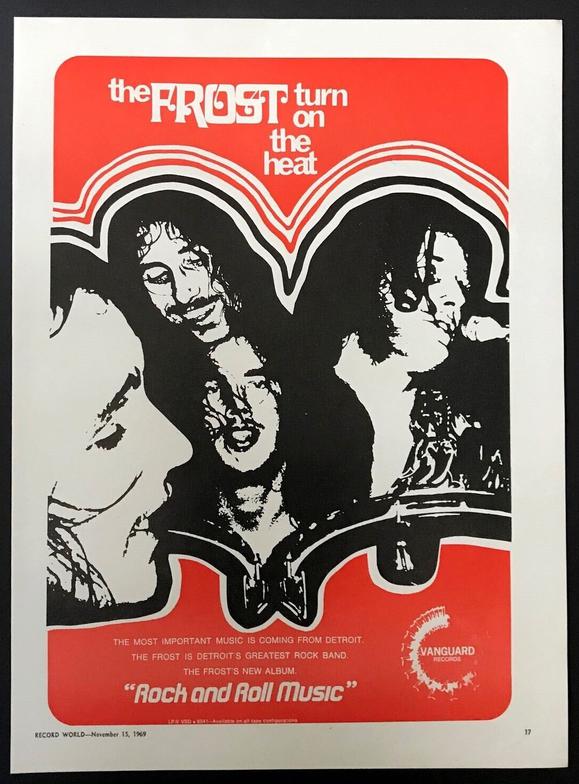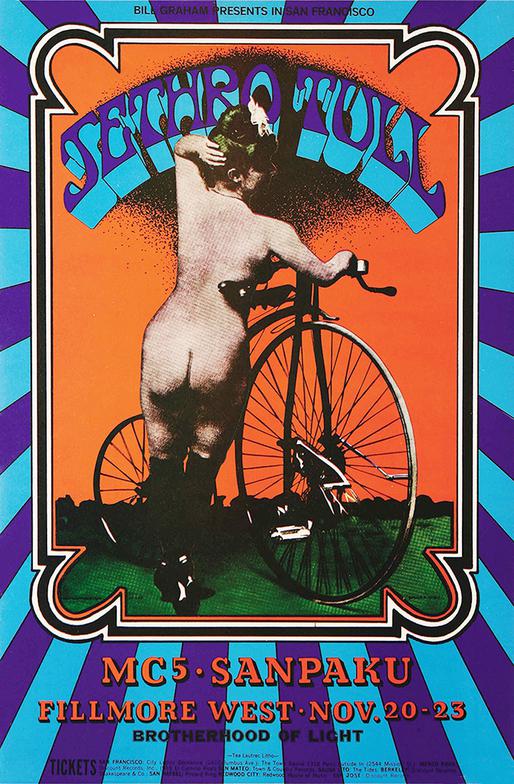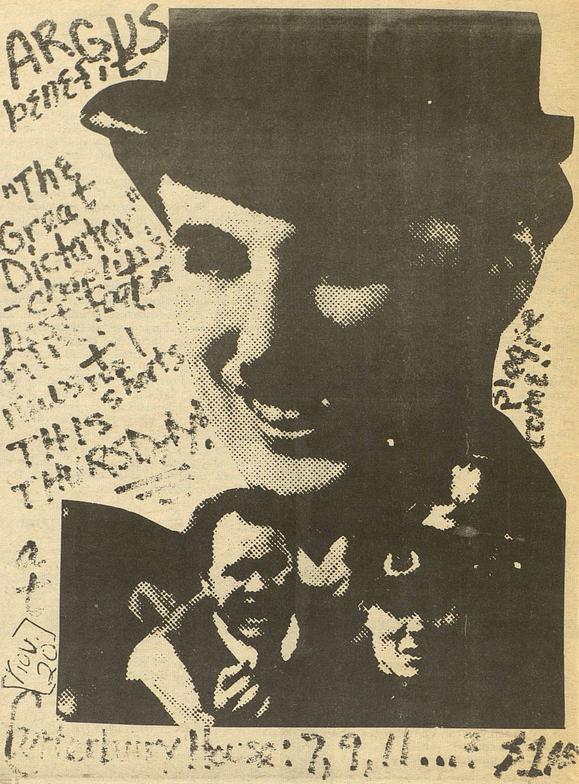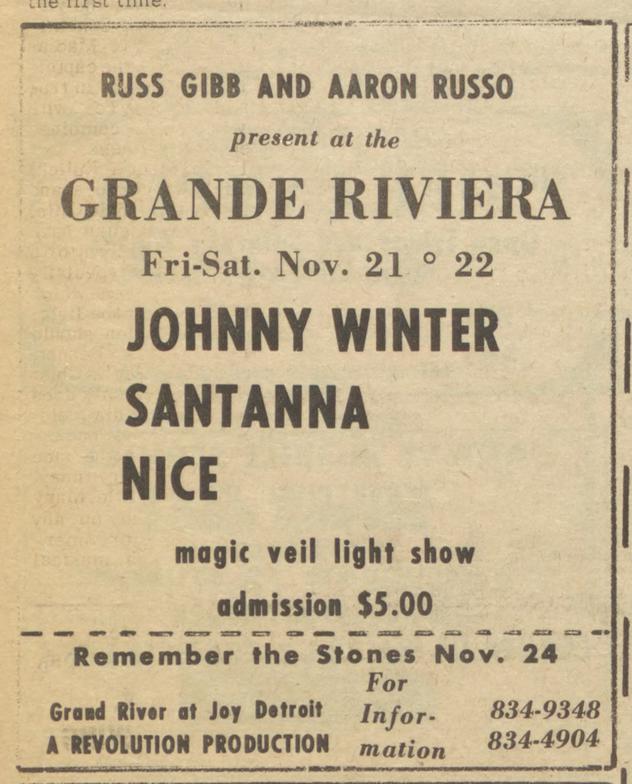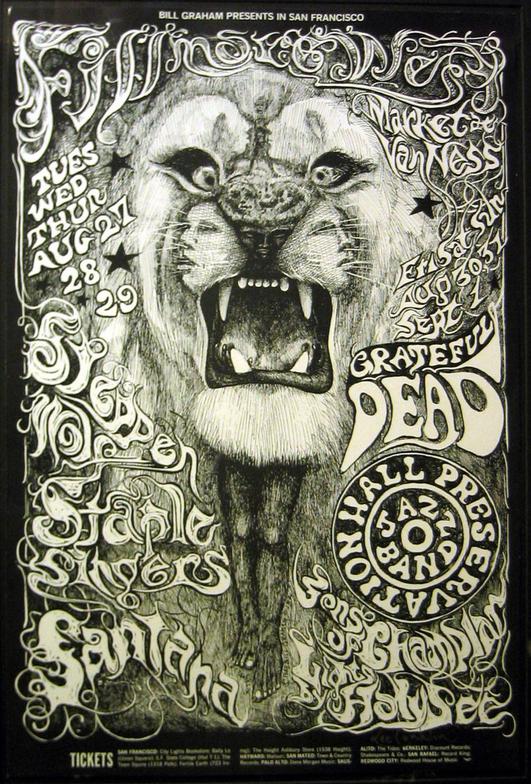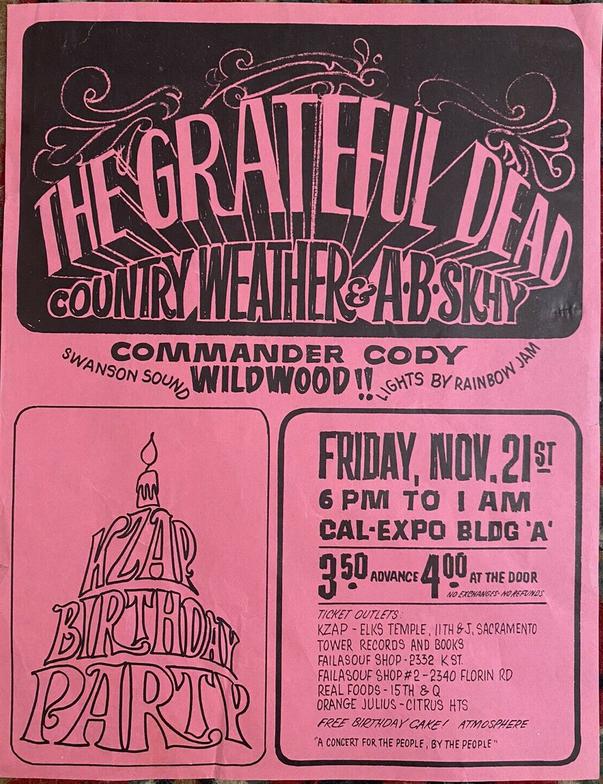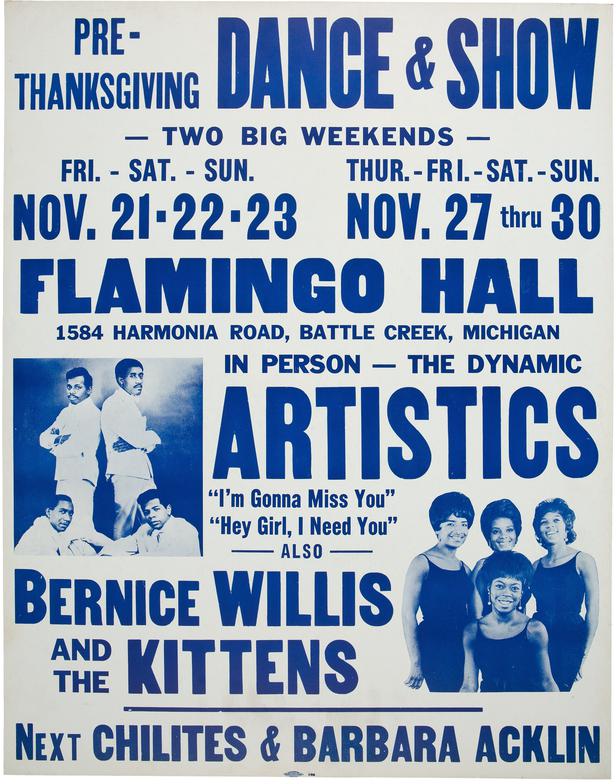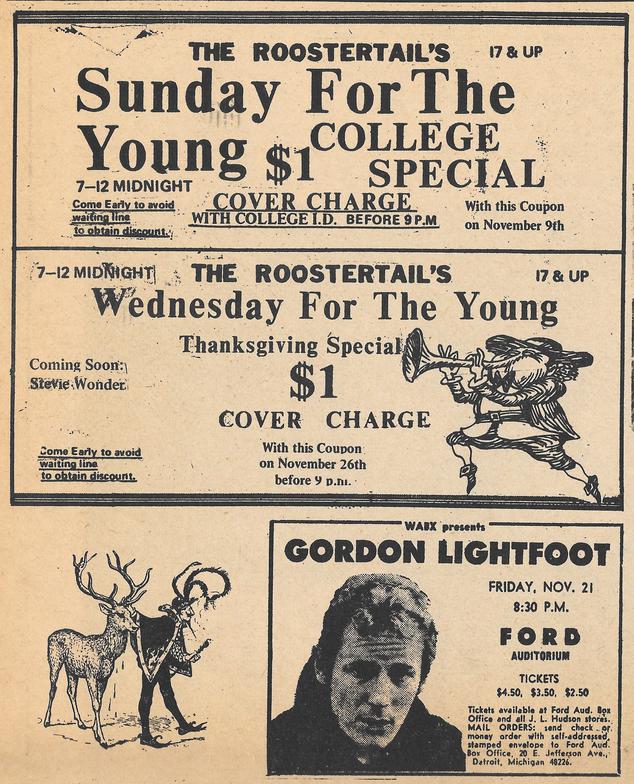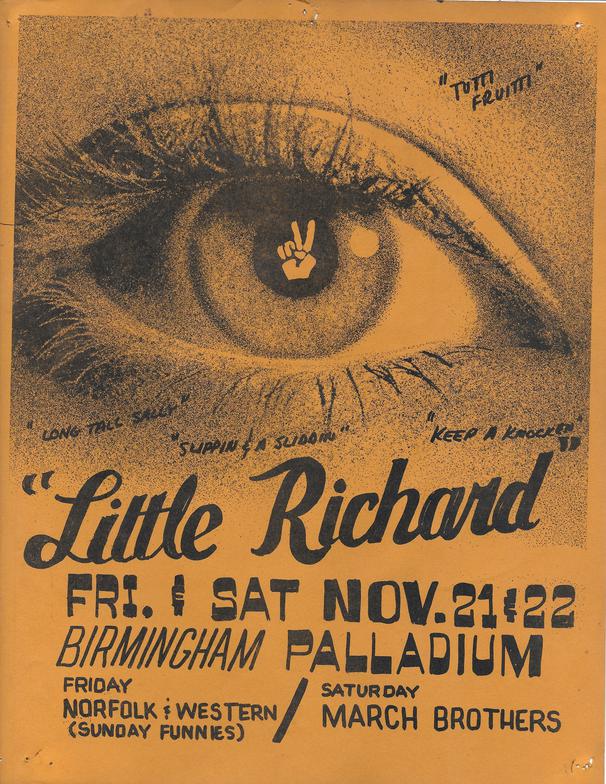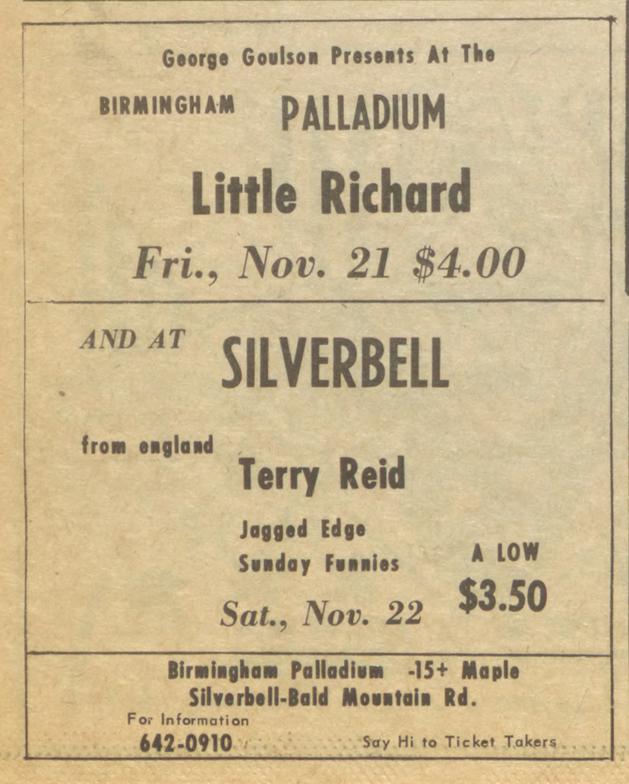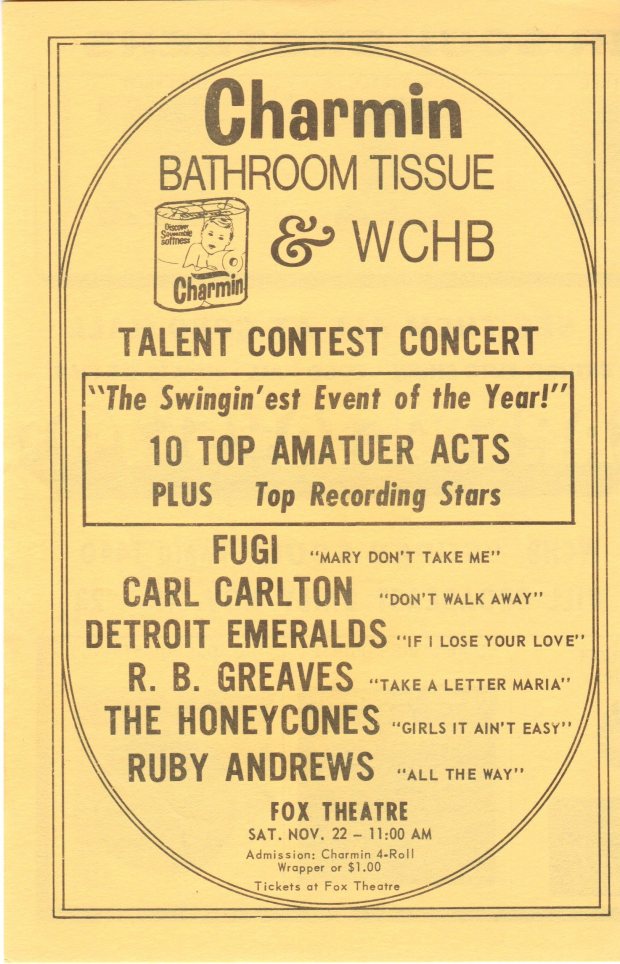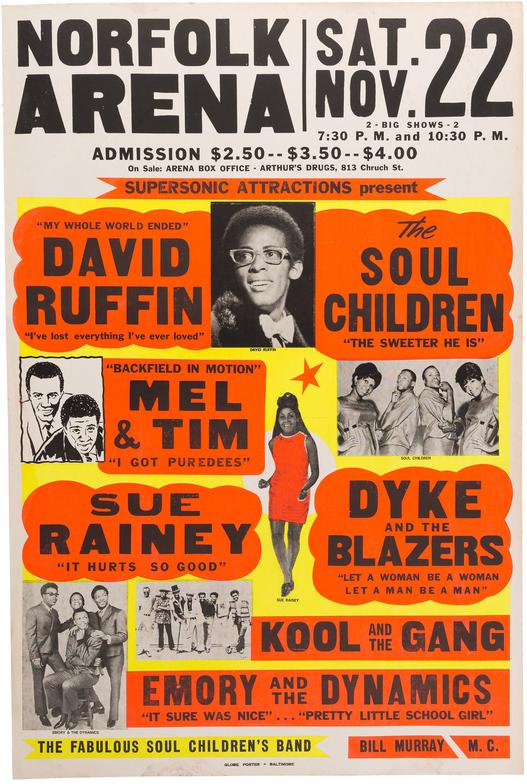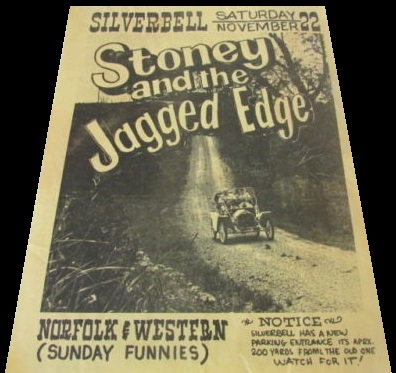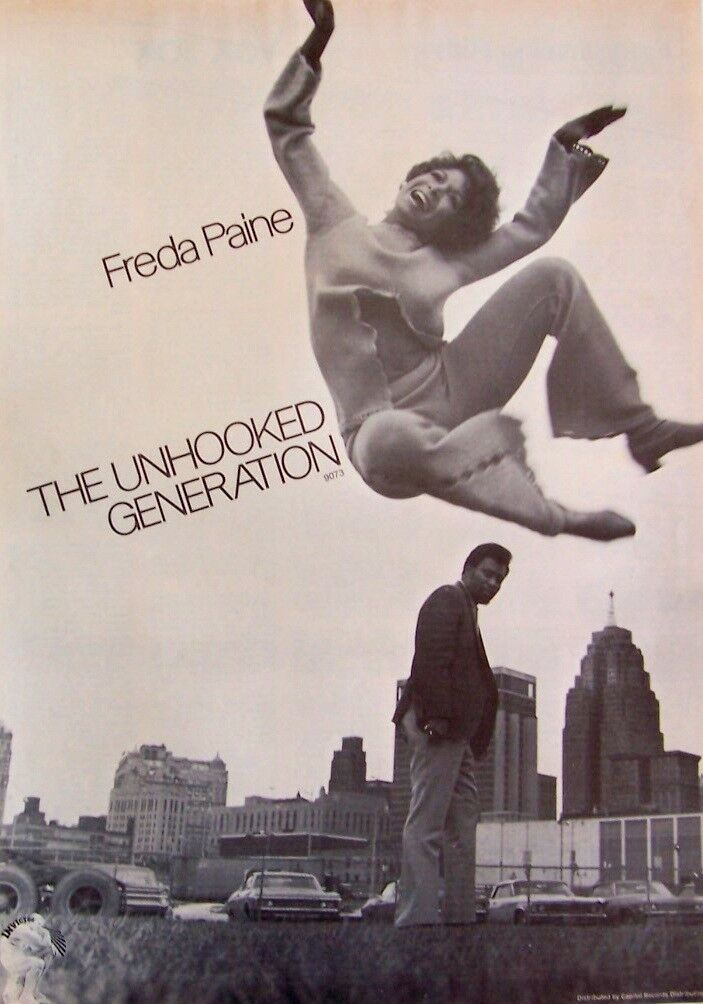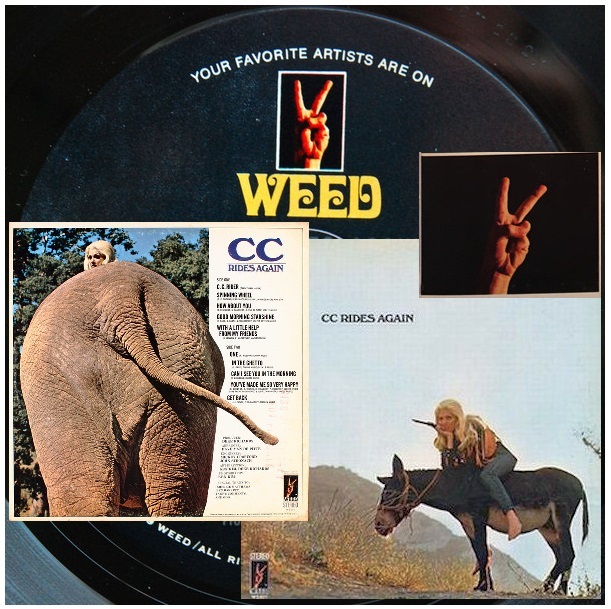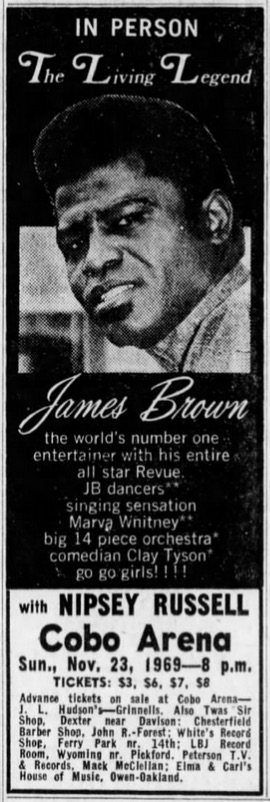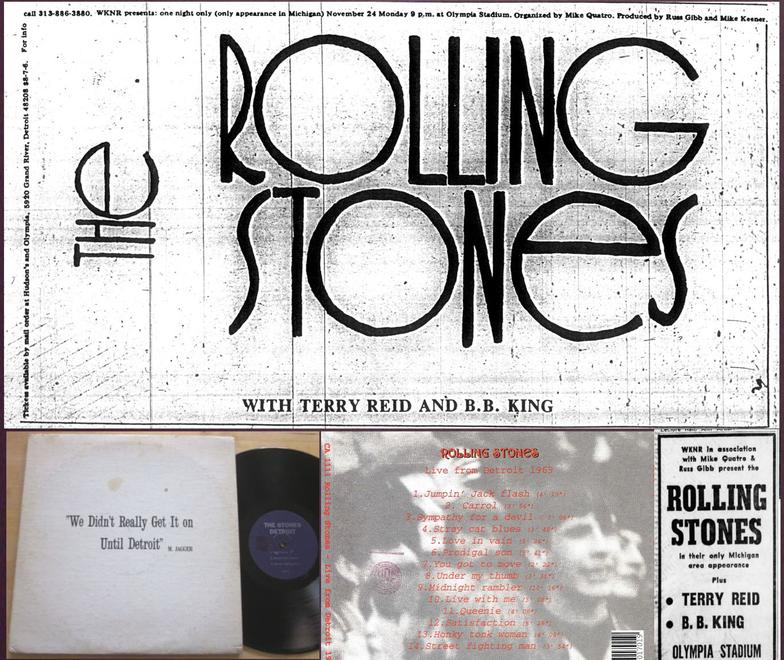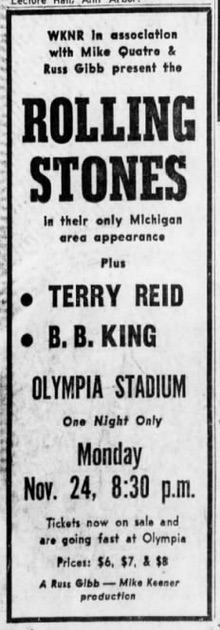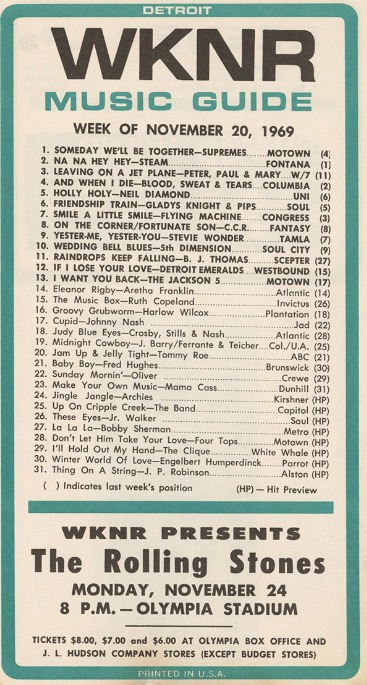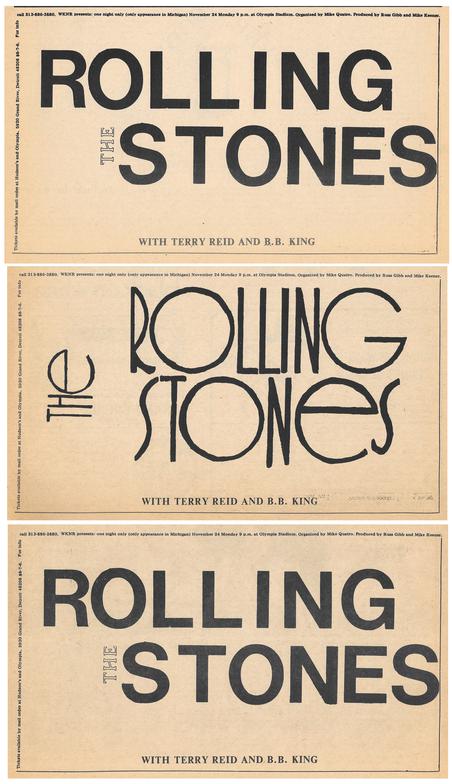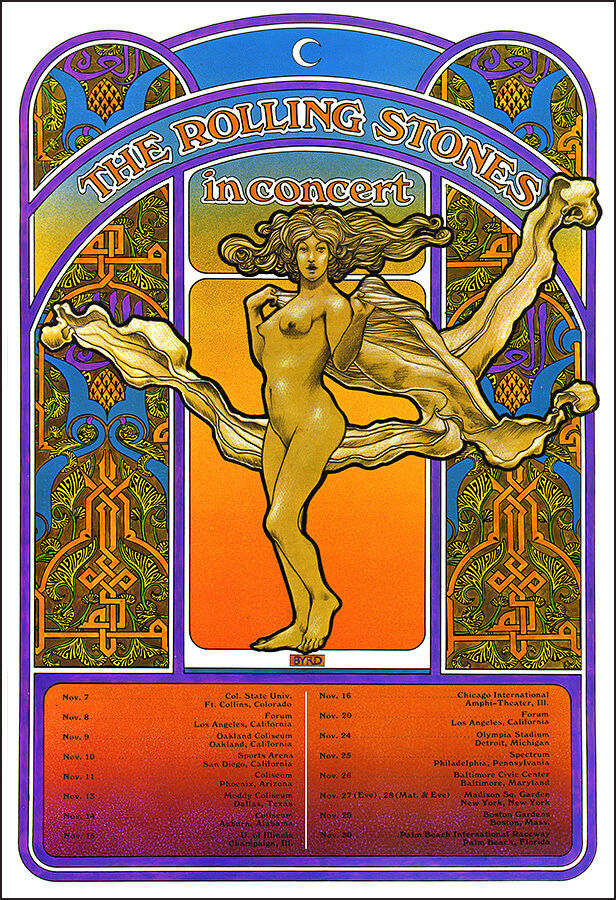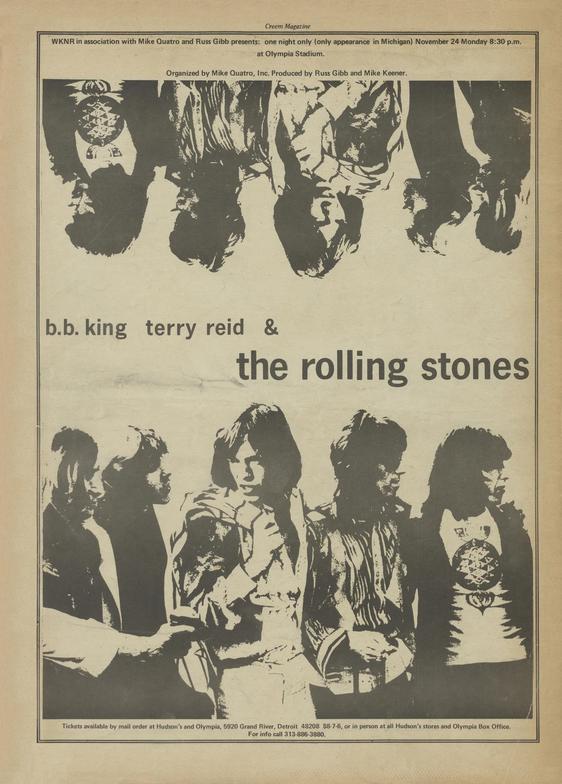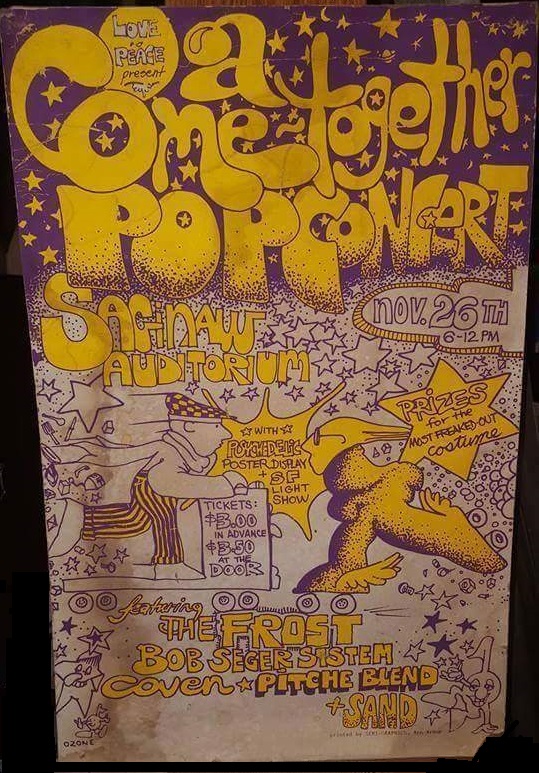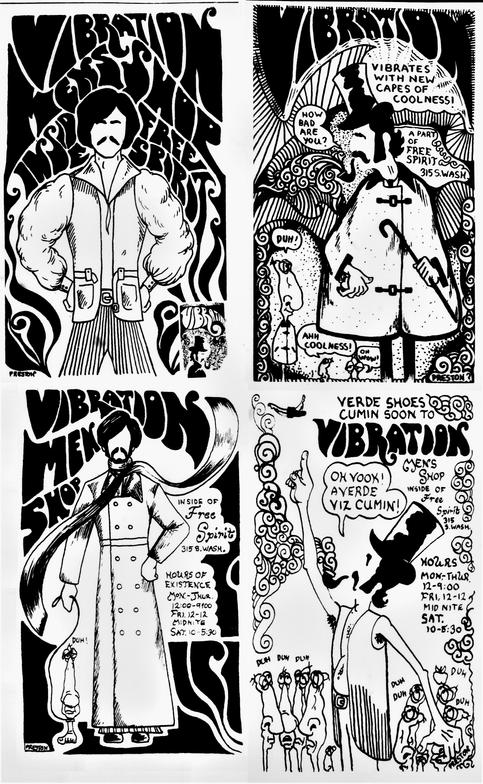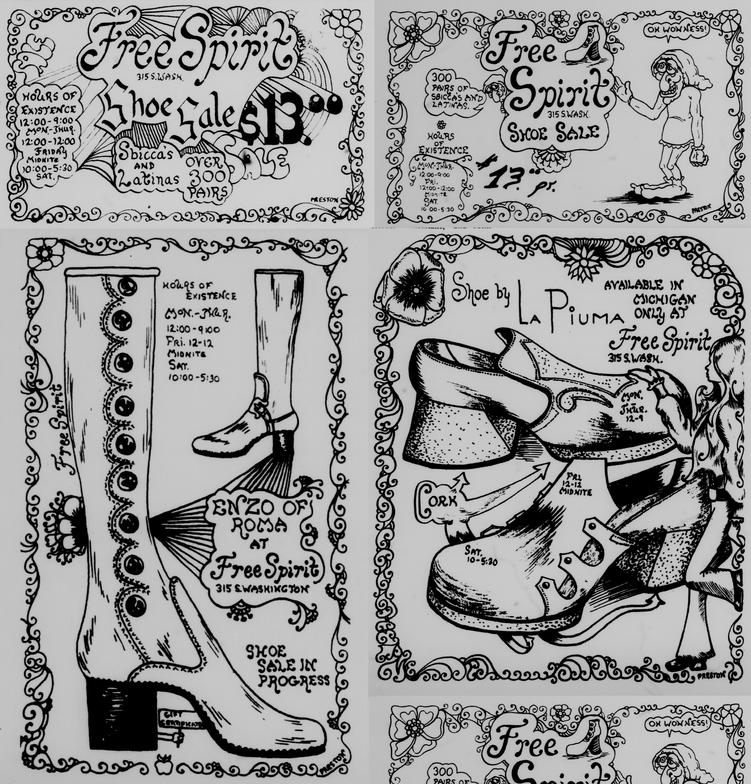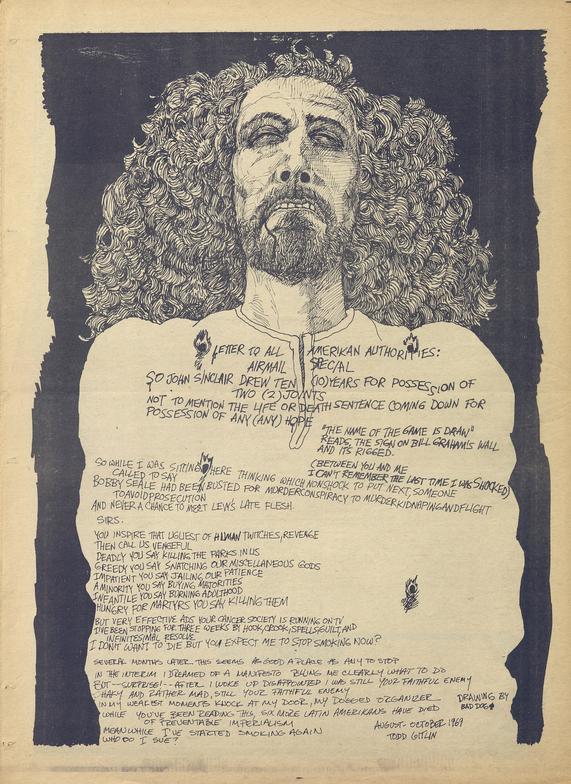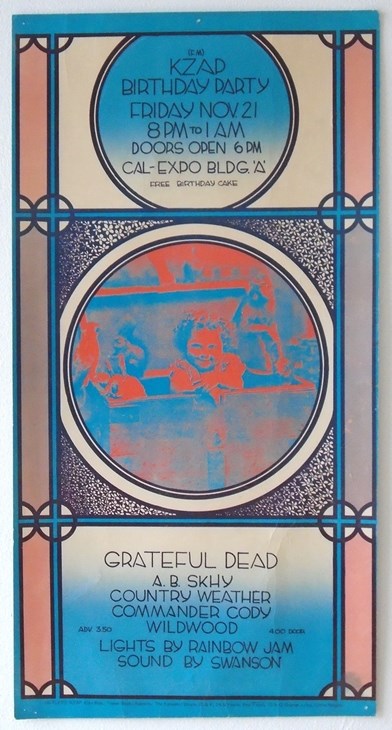Splatt Gallery
Double click here to add text.
Splatt Gallery's History of Michigan Concert Posters
Volume Five - 1969 - Page Twenty-Two
Tour poster for The Kinks 1969 American Tour, showing a stop at the Grande Ballroom in Detroit, Michigan, November 7-8, 1969. We know this was actually at the Grande Riviera, but we’ve seen even the Detroit newspapers get this wrong.
This was the first Michigan appearance by the Kinks, finally free from a four-year ban prohibiting them from performing in the US, as the result of their disastrous 1965 tour which we chronicled earlier.
There was some question as to whether the Kinks made it to this show, as it is not listed in the Concert Database and we knew the story that Kinks guitarist Dave Davies injured his hand during some mischief with Who drummer Keith Moon after the Kinks’ performance with the Who in Chicago, causing the Kinks to cancel subsequent shows. The Detroit show, however, is described by Ray Davies in his 2013 book “Americana”:
“On Dave’s return, we traveled to Detroit, where we were to play along with Joe Cocker, Grand Funk Railroad, and the James Gang. I don’t know what state of mind Joe Cocker was in, but he appeared to walk through a partition on his way to the stage. I was already feeling slightly alienated by the machismo displayed by the other bands on the bill, so during our own set I slipped into vaudeville mode by telling a few bad jokes by the legendary British comedian Max Miller. I was greeted with stunned silence by the hard-core Detroit rock audience.”
**********************************************************
Newsprint version of The Kinks 1969 American Tour poster, with shows at the Grande Ballroom (actually the Grande Riviera) in Detroit, Michigan, November 7-8, 1969.
A half-page Reprise Records ad in the November 1969 issue of CREEM magazine for the album “Arthur” by the Kinks, coinciding with their shows at the Grande Riviera in Detroit, Michigan, November 7-8, 1969.
A pair of ads for Commander Cody & His Lost Planet Airmen returning to the Canterbury House in Ann Arbor, Michigan, November 7-9, 1969.
An ad for the Kinetic Playground in Chicago, Illinois with Grand Funk Railroad scheduled to open for Jethro Tull for two shows that never happened. A fire after the show on the night of November 7, 1969 closed down the venue and cancelled the upcoming shows. Aaron Russo went to Detroit to help Bob Bageris manage the Eastown Theater and later became Bette Midler’s manager.
On November 8, 1969, an “Inter-Galalic (sic) Psychedelic Light Show with two bands” was held at Green’s Pavilion in the Irish Hills of Devil’s Lake, Michigan. There would be two more weekends of shows, Featherstone with Dhobi’s Itch, and March Brothers with Northwind, and then Green’s would call it quits, ending a forty-year history that went from the Big Bands of the 30’s and 40’s, through the early rock and rollers, to The Yardbirds and Seger.
On this night, the Canadian band Madrigal performed with Tacklebox. Madrigal had just recorded their first single. We would love to hear Tacklebox.
Madrigal – I Believe in Sunshine (1970)
https://www.youtube.com/watch?v=pyLrK473-eg
Flyer/handbill by an unknown artist for Wilson Mower Pursuit at the Crazy Horse in Kalamazoo, Michigan on November 8, 1969, followed by Frost with Rock Candy the following day, November 9th.
Newspaper ad by Dave Baker, for a fraternity open house at the University of Michigan in Ann Arbor on November 9, 1969 and again on November 23.
An amazing line-up for the Day of Peace, November 11, 1969, which was planned as a follow-up to the Halloween Black Magic show at the Olympia Stadium in Detroit, but with the trouble caused at the end of that show, the Day of Peace was cancelled. Poster by Chris Frayne (Ozone).
A second version poster for the cancelled Day of Peace concert, also by Chris Frayne (Ozone).
An open letter, on what looks to be SRC letterhead, from the promoters of the “Day of Peace” concert, Peter Andrews, Cholly Bassoline, and Larry Benjamin, to the incredible line-up of bands scheduled to appear on November 11, 1969. It was planned to take place at the Olympia Stadium in Detroit, but unfortunately it was cancelled, in no small part because of the disastrous Halloween Night “Black Arts Festival” at the same venue.
An ad for WXYZ-FM radio in Detroit, Michigan in the November 12, 1969 issue of the student newspaper at Oakland University in Rochester.
A full-page Motown Records ad for the Supremes and the Temptations television special “G.I.T. (Getting’ It Together) on Broadway”, also known as “Diana Ross and The Supremes and The Temptations on Broadway”, broadcast on November 12, 1969. A soundtrack album for the special was issued five days before the program aired.
Poster for the second weekend at the newly christened Birmingham Palladium, November 14-15, 1969, poster by Ken Victor “Wiktor”. Performers were Jagged Edge, Sons (formerly of Champlin), Promise, and Plain Brown Wrapper.
How do you lose an airplane? For such a high-profile group as the Jefferson Airplane, documentation of their whereabouts in November, 1969 is surprisingly sketchy. One of the websites that compiles JA touring history, after presenting and ruling out specific dates, somewhat exasperatedly concludes, “Clearly the Airplane played a show or two in Detroit this week, but exactly when is murky”.
The dates of November 2, November 11-12, and November 14-15 are all posited, ultimately we believe the concert database dates of November 11-12 at the Eastown Theater, but why is there little to no proof, no concert posters, not even a simple newspaper listing to be found. How did those in attendance even find out they were happening?
Further complicating things, there is agreement that one of the two scheduled shows was cancelled, of course some say it was November 11, while others say November 14. One reason given for the cancellation is that the JA’s equipment truck driver was detained at the border. We presume they mean the Canadian border, but what were they doing coming into Detroit from Canada? Shows that are listed prior to any of the prospective Detroit shows are “dubious”, “presumably”, “possibly”, and “unconfirmed” and range as far apart as from New York to Los Angeles, perhaps it was Chicago, but nobody travels from Chicago to Detroit by going through Canada. One of the sources that puts the Detroit show at November 15 also has them performing in Iowa City, Iowa on the same date.
The most contemporary account that we’ve found is from the tour diary of Richard (Vick) Vickers, roadie for King Crimson, who opened for the Airplane and confirms the date of November 12, 1969. In true roadie-speak, here is how he describes opening for The Band, two days after playing the show with the Airplane:
“Two days later (after the Jefferson Airplane) we played a different hall in Detroit. This tour was just getting better and better, and I’d wanted to see the acts that were headlining ever since hearing their stuff at London’s UFO Club where I’d worked some 2 or 3 years earlier.
“I think it was Jagger who that year said “We never got it on until Detroit.” We understood why too — what an audience!! The best I’ve ever heard - and didn’t they let you know it!!!
“There were only 2 American bands that I knew who had WEM PA systems. Big Brother & the Holding Company featuring Janis Joplin, and The Band. In Detroit we linked our WEM PA up with The Band’s and for the first time mixed front of house. We couldn’t get very far away from the front of the stage as we didn’t have a multicore, but the difference it made was considerable. Having four Audiomaster mixers hooked up instead of the usual two was luxury indeed, and The Band were just incredible live.”
The one thing that Vickers gets wrong is that, in his account, they opened for the Airplane at the Grande Riviera and opened for The Band at the Eastown Theater, but there is one final comment from the crew belies that mistake when it says, “We also played another Detroit theatre, the Grande, with Jefferson Airplane. We were not impressed by either.” From what we know, the Grande Riviera was nicer than the Eastown, so we’re pretty confident that the Crimson crew got the names of the venues mixed up. Otherwise, this all fits with the conclusion that Jefferson Airplane with King Crimson, Eastown Theater, November 12, 1969, and The Band with King Crimson, Grande Riviera, on November 14-15, 1969.
On a final end-note, here is a first-hand account (but getting the date wrong again) of the JA show:
“The Detroit show was Nov. 15, 1969. I was at that show and it was truly spectacular - certainly the best concert I attended during the 1960s and 70s. The show the night before had been cancelled (the Airplane's equipment truck driver got busted at the border) and they didn't want to perform without their own equipment and light show. They did one long set, close to 2-1/2 hours. I smuggled in a cassette recorder but the volume completely overloaded the deck and the tape was basically useless. Really unfortunate because it was an amazing show by a band pretty much at the peak of its game.”
Full-page photo of Grace Slick by Charles Auringer in the November 1969 issue of CREEM magazine, coinciding with the Jefferson Airplane’s concert at the Eastown Theater in Detroit on November 12, 1969.
Print ad for the fifth weekend at the Grande Riviera, November 14-15, 1969, with the first Michigan appearances for The Band and the Pretty Things. King Crimson extended their stay in town after opening for the Jefferson Airplane at the Eastown Theater two days earlier. Note the formal association of Russ Gibb and Aaron Russo.
King Crimson – In the Court of the Crimson King (1969)
https://www.youtube.com/watch?v=x4VTwWz2tj4
Ads by Robert Daniel for Dionne Warwick and Woody Herman at Campbell’s Union in East Lansing, Michigan, November 15, 1969.
A two-page spread in the November 15, 1969 issue of Billboard Magazine that makes a nice colorful poster of the “Motown Assembly Line”.
A real nice poster by “Lyman”, printed by the Washington Poster Co. for the Temptations at the University of Oregon on November 15, 1969.
Poster by an unknown artist for an appearance by the band The Brotherhood at the Absolute Zero Coffee House in Detroit, Michigan, November 15-16, 1969.
Ad/flyer by an unknown artist for the Norman James Band at Alvin’s in Detroit, Michigan on November 16, 1969.
A full-page ad in the November 15, 1969 issue of Record World magazine for the second album by Frost.
Maybe it had been Russ Gibb’s outreach over the summer, or simply the passage of a year’s time, but it seems that Bill Graham had gotten over his grudge against the MC5 and he booked them for four nights at the Fillmore West in San Francisco, November 20-23, 1969.
The poster is by Fillmore artist Randy Tuten, whose style, and especially his hand-lettering, is remarkably close to that of Gary Grimshaw’s.
Another benefit for The Ann Arbor Argus, a film showing at the Canterbury House in Ann Arbor, Michigan, November 20, 1969.
Newspaper ad for the sixth weekend at the Grande Riviera in Detroit, Michigan with Johnny Winter, Santana and Nice,and the Magic Veil light show, a Revolution Production, November 21-22, 1969, also a note on the upcoming Rolling Stones show.
While researching Santana tour dates to confirm their shows at the Grande Riviera, we stumbled across a tangential, but not inconsequential, fact about legendary Fillmore artist Lee Conklin, best known for his cover art on the first Santana album, which had also been a poster for a 1968 show.
It turns out that Conklin, born in New Jersey, was pursuing a career in History and Philosophy at Calvin College in Grand Rapids, Michigan when he began drawing cartoons for the school newspaper the “Calvin College Chimes”, circa 1964. The rest is psychedelic art history.
Poster/flyer with Commander Cody opening for the Grateful Dead at the KZAP radio station birthday party in Sacramento, California on November 21, 1969.
A real clean “boxing-style” poster by an unknown artist for a whole lot of soul in Battle Creek, Michigan, seven nights over two weekends, beginning on November 21, 1969. The groups were from Chicago, and we are so happy to find Bernice Willis & the Kittens, and to bring you, tonight, eight classic songs, nearly the entirety of their handful of singles.
We start off with the stomper “Ain’t No More Room” and its soulful flip side “Hey Operator”, their first single on Chess Records. Next up is their 1965 single “Lookie Lookie”/”We Find Him Guilty”, both tracks were written by the team of Ashford & Simpson, pre-Motown.
Next is the often-covered “Is It Over Baby?”, followed by their second and final release on Chess Records “I’ve Got to Get Over You”, and we close out with the torch song “(I'm Afraid) The Masquerade Is Over” that goes right over to its flip-side “It’s Gotta Be Love” for the upbeat closer. You could do worse on a Sunday night in pandemic America.
And now (doing our best Phil Dick impersonation) – Ladies and Gentlemen, we bring you – The Kittens!
The Kittens - Ain’t No More Room (1967)
https://www.youtube.com/watch?v=qejhKIxid24
The Kittens - Hey Operator (1967)
https://www.youtube.com/watch?v=o9RVg5RVtsQ
The Kittens - Lookie Lookie (1965)
https://www.youtube.com/watch?v=gbgIfZnrq0U
The Kittens - We Find Him Guilty (1965)
https://www.youtube.com/watch?v=kzGzRR10yjM
The Kittens - Is It Over Baby? (1966)
https://www.youtube.com/watch?v=ANJfUc3U1CY
The Kittens - I’ve Got to Get Over You (1968)
https://www.youtube.com/watch?v=O7ASLETe1c8
The Kittens - (I'm Afraid) The Masquerade Is Over / It’s Gotta Be Love (1966)
https://www.youtube.com/watch?v=GP2L68h7W7I
An ad for the Roostertail in Detroit, Michigan making an appeal to a younger audience with “For The Young” shows on Sundays and Wednesdays, plus an upcoming appearance by Stevie Wonder. Also, and ad for Gordon Lightfoot at Ford Auditorium in Detroit on November 21, 1969.
Poster by an unknown artist for Little Richard at the Birmingham Palladium in Birmingham, Michigan, November 21-22, 1969. Opening acts included the Sunday Funnies, March Brothers, and also the UP.
Newspaper ad for Little Richard at the Birmingham Palladium in Birmingham, Michigan on November 21-22, 1969, and Terry Reid with Jagged Edge and Sunday Funnies at the Silverbell.
Make what you will of a Great Detroit Musical Contest Finale sponsored by a brand of toilet tissue, the radio station WCHB could line up a fine roster of talent. Notable on this bill for the talent contest on November 22, 1969, is Fuji, who was Ellington Jordan, and the band he was paired with, of veteran Fortune, Golden World and Motown session musicians known as the Soul Agents, were already becoming known under a new name, Black Merda.
Fuji – Mary, Don’t Take Me on No Bad Trip (1969)
https://www.youtube.com/watch?v=fOmHzYhVb0Q
Full album:
https://www.youtube.com/watch?v=KJQjTQ3Klcc
A Globe Poster for a soul revue show in Norfolk, Virginia on November 22, 1969, with ex-Temptations singer David Ruffin on the start of his solo career. Also of note is the New Jersey band Kool & the Gang at the start of their career. The group had been in formation as early as 1964, but they had just settled on the band name, which was also the name of their first album, and also the name of the first track on the album.
Kool & the Gang – Kool & the Gang (1970)
https://www.youtube.com/watch?v=O9glHcEmNwM
Poster by an unknown artist for Punch Andrews’ Silverbell Hideout, November 22, 1969, with Stoney & the Jagged Edge on their comeback and the creativity of the poster probably due to the involvement of the Sunday Funnies, masquerading as Norfolk & Western.
Poster/ad for “The Unhooked Generation”, Freda Payne’s first single for Invictus Records, her name mis-spelled, released on November 22, 1969.
Freda Payne – The Unhooked Generation (1969)
https://www.youtube.com/watch?v=ne_4EWupm20
Two years after her debut album on Motown Records, Chris Clark’s second album was released on November 22, 1969. In an ill-advised marketing move, the company decided to change her image from the blue-eye soul chanteuse of 1967’s “Soul Sounds” to a flower-power hippie chick. The tracks on “C.C. Rides Again” were covers of Beatles songs, a song from the musical “Hair”, and covers of Nilsson, Blood, Sweat & Tears, and other current pop hits, made all the much more terrible by producer Deke Richards’ “absurdly pretentious flourishes including orchestral themes from then-current films like 2001: A Space Odyssey and Romeo and Juliet”.
The company even went so far as to create another Motown sub-label called “Weed” with the none too subtle sub-title, “Your Favorite Artists Are On Weed”. The logo, which looked like a take-off of the famous Stax Records’ finger-popping hand, was Clark’s own hand flashing the “peace sign”. “C.C. Rides Again” ended up being the only Weed Records release.
A good example of both the best (Clark’s talent) and the worst (Richards’ gunk) are found on the lead-off track “C.C. Rider”, where you will have to endure over a minute of the “William Tell Overture” before she starts to sing the song.
Chris Clark – C.C. Rider (1969)
https://www.youtube.com/watch?v=FgxVoE54jFY
Newspaper ad for the James Brown Revue with Nipsey Russell at Cobo Arena in Detroit, Michigan on November 23, 1969. It was Brown’s 15th Michigan show, going back to 1964, the year that accounted for seven of them.
The excitement had been building for weeks as the Rolling Stones were coming to Olympia Stadium, November 24, 1969, their first visit to Detroit in three-and-a-half years. A lot had changed with the band over that time, long-gone were days of matching suits, and judging by the unanimous rave reviews, always mentioning Jagger’s wardrobe and total command of the stage, no one was quite prepared as they witnessed the transformation into “the World’s Greatest Rock and Roll Band”.
Since their 1966 visit, Mick Jagger and Keith Richards had evolved into a monster song-writing team. It was the first time that a Detroit audience heard such stalwart classics as Jumping Jack Flash, Honky Tonk Woman, Sympathy for the Devil, Street Fighting Man, and Midnight Rambler.
The tour had started on the West Coast and it had taken a number of shows until the Stones found their groove with the new material. Jagger famously remarked, “We didn’t really get it on until Detroit”, which became the title for the bootleg record of this show.
The Rolling Stones – Live in Detroit (11/24/69)
https://www.youtube.com/watch?v=QBTWWGFwEGQ&list=PL0FCBEF32F03828EC
Newspaper ad, the WKNR Music Guide, and large print ads for the Rolling stones at the Olympia Stadium in Detroit, Michigan on November 24, 1969. Terry Reid and BB King were the opening acts, presented by Mike Quatro and Russ Gibb.
Tour poster by David Byrd for the 1969 Rolling Stones tour, with a show at the Olympia Stadium in Detroit, Michigan, November 24, 1969. Detroit is listed third down in teh right hand column.
A full-page ad/poster on the back cover of CREEM magazine for the Rolling Stones with B.B. King and Terry Reid at the Olympia Stadium in Detroit, Michigan on November 24, 1969.
Another very cool poster by Chris Frayne (Ozone) for a Come Together Pop Concert at Saginaw Auditorium, November 26, 1969, featuring Frost, Bob Seger System, Coven, Pitche Blend, and Sand.
A collection of Dennis Preston ads for the Vibration store and the Free Spirit boutiques in Lansing, Michigan from November 1969.
Poster from the November 27, 1969 issue of The Fifth Estate by Al Shamie (Bad Dog).
Volume Five - 1969 - continues - HERE


